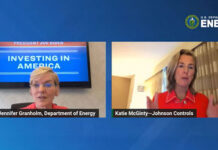By Anne Cosgrove
From March/April 2023 issue
Shortly after taking office, Maryland Governor Wes Moore announced his preliminary FY 2024 Budget Plan that outlines two priorities for economic growth, including $500 million to fund the Blueprint for Maryland’s Future and $500 million dedicated to support strategic priority transportation projects across the state that align with the governor’s economic competitiveness goals.
The Blueprint for Maryland’s Future is a landmark legislation passed in 2021, which includes comprehensive changes to nearly every aspect of Maryland’s public education system. Increasing annual education funding by over $3.8 billion over the next 10 years, the Blueprint will enrich student experiences, accelerate improvements to student outcomes, and improve the quality of education in Maryland.

By the 2023–2024 school year, each local education agency, in collaboration with the community colleges, shall develop and implement a program of study for students who have not met the College and Career Readiness standard by the end of the 10th grade.
Beginning in the 2023–2024 school year, each local education agency shall provide all students who meet the College and Career Readiness standard with access to the statutorily required post College and Career Readiness (post–CCR) pathways, at no cost to the student or the student’s parents/guardians, including the cost of any fees.
Green Action
Meanwhile, Gov. Moore reaffirmed his commitment to combating climate change by announcing Maryland’s participation in the U.S. Climate Alliance. He proposed a $422 million investment in protecting the state’s environment through programs funded by the transfer tax that supports land preservation and operations and capital projects in state parks—along with another $129 million in General Funds to fully fund the transfer tax repayment provision as revised by the Great Maryland Outdoors Act.
“We are often told climate change is a problem for the future, something you only have to worry about if you live on farmland or in a flood zone—but climate change is an existential threat for our entire state, and it is happening now,” said Gov. Moore.
“Confronting climate change represents an opportunity for Maryland to lead—and together, we can be a leader in wind technology, in grid electrification, and in clean transit.”
By joining the U.S. Climate Alliance, Maryland has committed to achieving the Paris Agreement’s goal of keeping temperature increases below 1.5 degrees Celsius by reducing collective net greenhouse gas emissions; collectively achieving overall net-zero GHG emissions as soon as practicable, and no later than 2050; and accelerating policies to reduce GHG pollution, building resilience to the impacts of climate change, and promoting clean energy deployment.
Global Exports
Maryland Commerce recently awarded several rounds of ExportMD grants, and many recipients utilized the funding to travel to Arab Health. ExportMD grants are provided to small and mid-size companies on a monthly basis to assist with travel and marketing costs associated with international trade shows.
“Annual events like the Arab Health exhibition help showcase Maryland and its innovative businesses to an international audience,” said Maryland Commerce Assistant Secretary of Business & Industry Sector Development Heather Gramm. “With a robust life sciences industry and numerous healthcare companies, we can easily demonstrate that Maryland is the prime destination for global industry leaders looking to expand to the U.S.”
The 11 Maryland companies traveling to Arab Health as part of the delegation include Alliance Care Technologies (Easton); BC3 Technologies (Baltimore); ClickMedix (Gaithersburg); Homeland Custodial Services (Columbia); Integrated Pharma Services (Rockville); Konsyl (Easton); Man & Machine (Landover); OMM Collection (North Bethesda); PediaMetrix (Rockville); Pevco (Middle River); and Supplema (Hunt Valley).
Alliance Care Technologies, an artificial intelligence-driven healthcare company, traveled as part of Maryland’s Arab Health delegation for the first time in 2022. The Talbot County company is looking forward to expanding on last year’s success, as well as the potential for more sales and new customers.
“We were thrilled with the opportunities for partnership and networking last year,” said Michele Tarnow, CEO of Alliance Care Technologies. “Exhibiting again at Arab Health will help us build stronger partnerships in the Middle East, Africa, and South Asia region. In addition, our team members will continue to build beneficial relationships with the Maryland delegation for mutual interests and future growth.”
Bringing Business Home
“Makerspaces” can be many things at once: part classroom, part community center, part art studio, part workshop where hobbyists can tinker, even part business incubator and co-working space. They can also be a powerful tool for economic growth, community revitalization, creating jobs, and developing the state’s manufacturing workforce.
Now, there is a new program at TEDCO to boost both the number and the impact of makerspaces across Maryland. The Maryland Makerspace Initiative Program, created by the Maryland General Assembly earlier this year, will provide grants to support the expansion and establishment of makerspaces by organizations and local governments across Maryland.
“This really positions Maryland at the top for supporting the development of makerspaces,” said Dorothy Jones-Davis, Executive Director of Nation of Makers, a national nonprofit focused on providing support and advocacy for the maker ecosystem.
Maryland seems to be the first state in the country to establish such a program, which is designed to foster a community of makerspaces rather than a single facility. A particular benefit of the enabling legislation behind the new program is that it offers a definition of makerspace that should help people understand the value of such facilities, Jones-Davis said.
Facilities like the nonprofit Open Works in Baltimore, which served as a model for the new program, provide access to a range of tools and technology—including table saws, sewing machines, welders, laser cutters, and 3D printers—and offer a variety of classes and programs.
Amateurs and DIY enthusiasts might use a makerspace to sharpen their skills before taking on a new project; entrepreneurs, startups, and small businesses might use the facility for product design and prototyping; artists could use shared studio space. Open Works has even partnered with Baltimore City on a two-year apprenticeship program to train industrial sewing machine operators.
“There’s no one-size fits all model,” Jones-Davis said. “These spaces are multifaceted and are uniquely able to fill different needs of communities.”
Will Holman, Executive Director of Open Works, who was a key supporter of the enabling legislation that created the new program, notes that makerspaces can play a unique role in supporting the growth of small businesses in their communities.
“We tend to think of economic development as top-down: big projects with major infrastructure investment and a lot of construction jobs,” Holman said in an interview. Makerspaces, however, can be an invaluable resource for smaller enterprises and individuals who are starting out with little more than an idea—or “one person with a dream,” Holman said.
Since 2016, 211 small businesses have used Open Works resources to create 118 jobs and generate nearly $10 million in annual economic output, according to Holman.
The community was also able to mobilize and pitch in during the early, hectic days of the COVID-19 pandemic: in March 2020, Open Works organized a network of 388 volunteers from across the state to produce nearly 30,000 units of much-needed personal protective equipment while supply chains were strained.
A robust community of makerspaces would amplify the achievements of facilities like Open Works.
In 2019 alone, Open Works provided technical education classes to 1,339 adults and 171 youth; a network of five locations, for example, could provide that level of training to thousands of people across the state, produce $45 million in annual economic impact, and generate $2.25 million in annual tax revenues. It would also create hundreds of new jobs both directly and through the growth of new startup companies, Holman wrote to Maryland lawmakers in his testimony supporting the legislation.
“My personal hope is for a facility on the scale of Open Works in every county in the state,” Holman said. These facilities would be tailored to the needs of their respective counties, but “share DNA” regarding the curriculum and tools, so skills learned in Talbot County, for example, could easily be transferred to Baltimore City or elsewhere, Holman said.
This network would help meet a growing need for technical education and skills, he said. “This is how we’re going to grow economically, as a state.”
Cybersecurity Center Renewed
This spring, the Department of Commerce’s National Institute of Standards and Technology (NIST), the state of Maryland and Montgomery County, Maryland, renewed their partnership in support of the National Cybersecurity Center of Excellence (NCCoE), a collaborative hub where industry, government and academic experts work to solve pressing cybersecurity challenges.
The NCCoE, established in 2012, helps businesses secure their IT systems with solutions based on industry standards, best practices, and commercially available technology. At the renewal event, U.S. Deputy Secretary of Commerce Don Graves also announced the launch of the NIST Small Business Cybersecurity Community of Interest (COI). Small businesses will have a community dedicated to their specific needs and issues.
















![[VIDEO] Get More for Your Business in Ardmore. Oklahoma](https://businessfacilities.com/wp-content/uploads/2024/02/maxresdefault-324x160.jpg)
